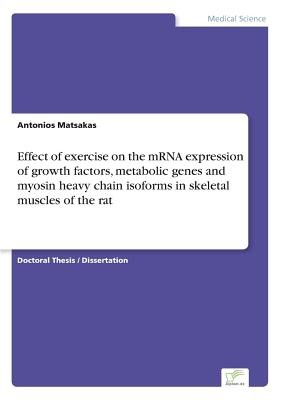
- We will send in 10–14 business days.
- Author: Antonios Matsakas
- Publisher: Diplom.de
- Year: 2004
- Pages: 126
- ISBN-10: 3838682939
- ISBN-13: 9783838682938
- Format: 14.8 x 21 x 0.8 cm, minkšti viršeliai
- Language: English
- SAVE -10% with code: EXTRA
Effect of exercise on the mRNA expression of growth factors, metabolic genes and myosin heavy chain isoforms in skeletal muscles of the rat (e-book) (used book) | bookbook.eu
Reviews
Description
Inhaltsangabe: Abstract: Skeletal muscle is a complex and heterogeneous tissue capable of remarkable adaptation in response to various stimuli such as exercise training. Molecular biology approaches have made a large contribution to our current understanding of how mechanical loading can alter gene expression and muscle protein synthesis rates in skeletal muscle. The steady-state level of a given mRNA is a function of both its rate of synthesis and its rate of degradation, implying that the rate of change in response to a cellular stimulus is dependent on the dynamics of mRNA turnover. Changes in muscle mRNA steady-state levels can be taken as an index of changes in gene expression, constituting currently one of the best described and understood molecular events that underlie muscle plasticity. The discovery of new growth factors involved in the regulation of muscle development provides a better understanding of the molecular mechanisms involved in the adaptation of skeletal muscle to exercise training. Since it has been shown that changes in contractile function can be brought about by switching on one subset and repressing another subset of genes, it was hypothesized that the steady state level of multiple mRNAs (growth factors and metabolic genes) involved in regulatory functions in a muscle -which is frequently recruited during exercise- is different between endurance trained versus untrained rats. Recent scientific data indicate that myostatin constitutes a limiting factor in normal muscle development playing a crucial role in skeletal muscle hypertrophy. Nevertheless, there are only scarce data so far about the role of myostatin in the exercise-induced skeletal muscle adaptation. The transient changes in regulatory and structural gene expression provide the molecular basis of the adaptability of the skeletal muscle to exercise stimulus. To get an insight into the molecular mechanisms of skeletal muscle adaptation, the main objective of this study was to ex
EXTRA 10 % discount with code: EXTRA
The promotion ends in 21d.02:18:23
The discount code is valid when purchasing from 10 €. Discounts do not stack.
- Author: Antonios Matsakas
- Publisher: Diplom.de
- Year: 2004
- Pages: 126
- ISBN-10: 3838682939
- ISBN-13: 9783838682938
- Format: 14.8 x 21 x 0.8 cm, minkšti viršeliai
- Language: English English
Inhaltsangabe: Abstract: Skeletal muscle is a complex and heterogeneous tissue capable of remarkable adaptation in response to various stimuli such as exercise training. Molecular biology approaches have made a large contribution to our current understanding of how mechanical loading can alter gene expression and muscle protein synthesis rates in skeletal muscle. The steady-state level of a given mRNA is a function of both its rate of synthesis and its rate of degradation, implying that the rate of change in response to a cellular stimulus is dependent on the dynamics of mRNA turnover. Changes in muscle mRNA steady-state levels can be taken as an index of changes in gene expression, constituting currently one of the best described and understood molecular events that underlie muscle plasticity. The discovery of new growth factors involved in the regulation of muscle development provides a better understanding of the molecular mechanisms involved in the adaptation of skeletal muscle to exercise training. Since it has been shown that changes in contractile function can be brought about by switching on one subset and repressing another subset of genes, it was hypothesized that the steady state level of multiple mRNAs (growth factors and metabolic genes) involved in regulatory functions in a muscle -which is frequently recruited during exercise- is different between endurance trained versus untrained rats. Recent scientific data indicate that myostatin constitutes a limiting factor in normal muscle development playing a crucial role in skeletal muscle hypertrophy. Nevertheless, there are only scarce data so far about the role of myostatin in the exercise-induced skeletal muscle adaptation. The transient changes in regulatory and structural gene expression provide the molecular basis of the adaptability of the skeletal muscle to exercise stimulus. To get an insight into the molecular mechanisms of skeletal muscle adaptation, the main objective of this study was to ex


Reviews